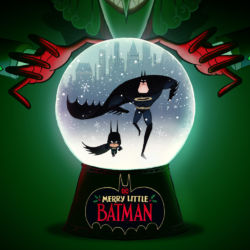Now available on Netflix, Chickenhare and the Hamster of Darkness is a CG animated film from Belgian animation studio nWave Pictures, based on the graphic novels of the same name by cartoonist Chris Grine. It follows Chickenhare, who (as you might have guessed) is a part-chicken, part-hare, who embarks on an adventure to stop his power-hungry uncle Lapin from gaining possession of the titular mystical artifact. If I had to describe in one word, it would be: perfunctory.
But first things first: I have not read the comics so I don’t actually know how faithful the movie is to them, but I was surprised to learn Chickenhare is an adopted prince, who was found by his hare father (Peter) and uncle as a baby. Peter became king of the island of Featherbeard despite being the younger brother because his father preferred him, and Lapin was imprisoned after trying to overthrow him.
However, despite his wealth and status, Chickenhare is ostracized for his bird-like feet and feathers, and his only friend is his turtle servant Abe. He believes he can gain popularity by joining the Royal Adventure Society, which he decides to do by finding the Hamster of Darkness, but he inadvertently releases his uncle in the process, turning his treasure quest into a search for redemption as much as acceptance.
As that synopsis somewhat suggests, this movie feels really thrown together: Chickenhare lives in a romanticized castle straight out of a Disney movie, but characters wear modern clothes, including the protagonist’s Indiana Jones-inspired gear. It’s a classic adventure story for kids too young to have seen Raiders of the Lost Ark, albeit with the plot of The Lion King, filled with desert taverns, jungles with hostile natives, and booby traps — and the plot never, ever circles back to the question of Chickenhare’s origins.
Like a lot of kids’ movies, this is about accepting yourself, and it’s mostly written and performed in utterly ordinary fashion (at one point Chickenhare straight up tells his father he wants to be “normal”): there’s an overwhelming sense it would’ve all been delivered with much more gusto in French, which is it how it would’ve been scripted. The animation is fine, the lighting and rendering more so, although there are occasionally jerky moments that remind you these European projects have far less budget and resources than their American counterparts.
A strong exception is Chickenhare and Abe’s hardy skunk guide Meg, who gets some solid writing and unique animation during a flashback about her backstory: it has a texture resembling felt stop motion, which is much more interesting than the movie’s typical, photoreal aesthetic, and she makes a genuinely insightful point about how, even after you accept yourself, there will still be people who mock you for who you are — if you’re a parent or guardian who watches the movie with a kid, it’s a moral well worth bringing up again.
Speaking of kids and adults, the film’s jokes for the older age bracket often fall flat, probably because of the aforementioned dialogue and acting, but also because for the most part there’s no real punchline to them beyond “haha, there’s unions and work hours in this universe.” One major example that didn’t pay off is the character of Luther, a gorilla who works for Lapin, who also has to bring his baby with him because his wife needs to work — like Chickenhare’s mysterious origin, the character is put aside and never mentioned again, when it would’ve been much better if he had turned on his boss at the end for being an uncaring leader. There’s also some self-aware meta jokes, but they also fall flat.
Furthermore, for all its attempts at a good message, I felt queasy seeing the colonial tropes of archaeology movies on full display in an Age of Discovery setting, where characters set sail on wooden sail ships like the explorers who brutalized and enslaved indigenous peoples around the world. A huge portion of the movie involves the three leads being held hostage by pigmies (no, that’s not a typo, they’re literally pigmies), a massive, featureless horde of savages capable of stacking on top of each other and becoming actual cubes in the progress: they’re thoroughly regressive stereotypes, callous and stupid (their religion only amounts to another of the film’s gags), and they’re led by an obese, legless chieftain, which feels similarly disdainful.
Overall, Chickenhare and the Hamster of Darkness is a generic talking animal adventure that might entertain kids for an hour and a half, but struggle to emotionally engage and amuse anyone over the age of ten (other than furries, and the jury’s still out on them.) Hopefully if nWave Pictures does a sequel, it’ll feel less like a cliched mishmash of other movies.






